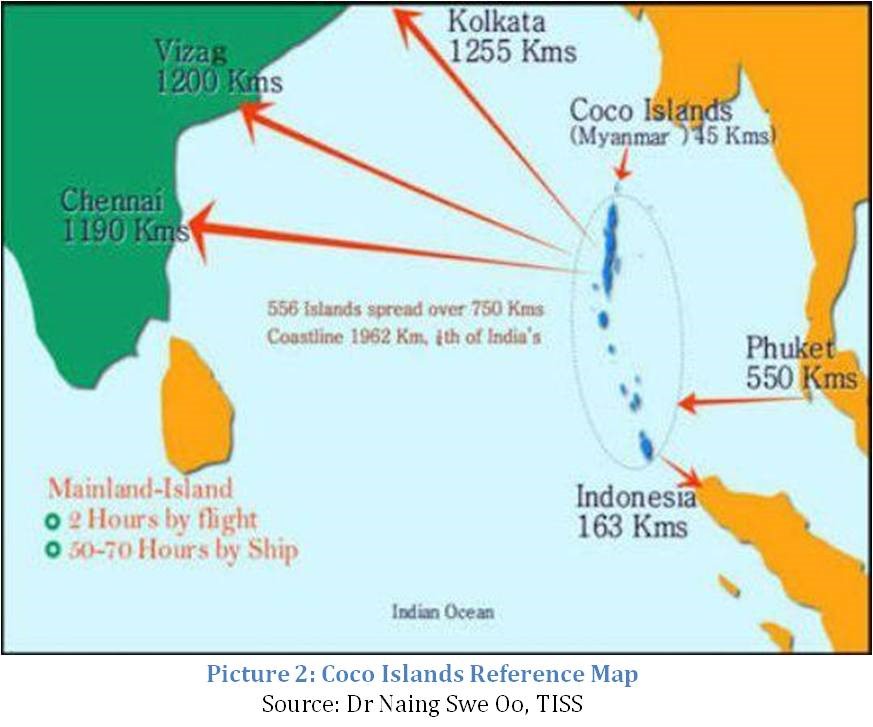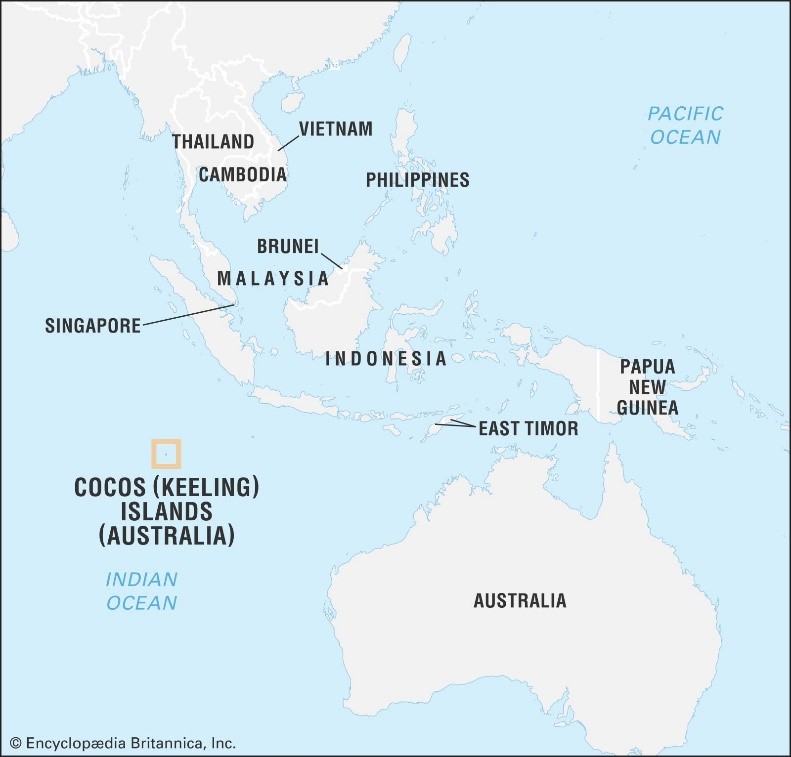Description

Disclaimer: Copyright infringement not intended.
Context
- An Indian Navy Dornier maritime patrol aircraft and an Indian Air Force (IAF) C-130 transport aircraft visited Australia’s Cocos (Keeling) Islands (CKI).
Cocos Islands
Location
- The Cocos (Keeling) Islands are an Australian external territory in the Indian Ocean, comprising a small archipelago approximately midway between Australia and Sri Lanka and relatively close to the Indonesian island of Sumatra.

Atolls and Islands
- The territory consists of two atolls made up of 27 coral islands, of which only two – West Island and Home Island – are inhabited.
Administration
- The territory is administered by the Australian federal government's Department of Infrastructure, Transport, Regional Development and Communications as an Australian external territory and together with Christmas Island (which is about 960 kilometres to the east) forms the Australian Indian Ocean Territories administrative grouping.
History of Cocos Islands
- Myanmar formerly known as Burma became a self-governing Crown Colony in 1937 after its separation from India with Coco Islands as Burmese territory.
- During the Second World War, the Andaman and Nicobar Islands and Coco Islands were invaded by Japanese forces.
- In 1943, the political jurisdiction of the Andaman and Nicobar Islands along with Coco Islands were handed over to the government in exile of Indian freedom fighter Netaji Subhas Chandra Bose then called the Azad Hind government.
- While political jurisdiction remained under Netaji Bose, the territorial control remained under the Japanese Navy. Coco Islands became part of Burma now known as Myanmar in 1948 when it regained independence from the British.
- Coco Islands became a concern for India ever since 1994 as Myanmar leased the island to the People’s Republic of China.
- The concern was regarding the possible monitoring of Indian missile launches into the Bay of Bengal and the Indian Ocean. Speculations regarding active Chinese presence in both Great Coco Island and Little Coco Island started in the 1990s.
- While there were frequent reports regarding the building of infrastructure, the acknowledgments were only limited to the building of runways, airstrips, and naval piers.
.jpg)
The strategic importance of Cocos Islands
- India’s Andaman and Nicobar Islands lie close to the Strait of Malacca, while Australia’s Cocos (Keeling) Islands are also located near strategic waters of Indonesia across from the Sunda, Lombok, and Wetar Straits. Taken together, these territories cover the entry and exit points of the Indian and Pacific Oceans.
- China’s ambition to become a Blue Water Navy and Indian domination of the Indian Ocean has put the region in a situation of power play where strategic buildups on the Coco Islands and Andaman and Nicobar Islands have become a strategy for both China and India.
- The Coco Island north of Andamans is strategically important to Myanmar too.
- China has shown keen interest in this island since last four decades. It is supposed to have a SIGINT facility to monitor Indian missile launches into Bay of Bengal and Indian Ocean.
Constructions
- An airstrip in Cocos Island is considered a Chinese construction.
- The airstrip at the Coco Island has been expanded over the last decade from 1300m to 1800m to 2000m to the present 2300m. Myanmar has actively reclaimed an area of 400m X 900m for possible expansion of the airstrip.
- A large naval pier (size 100m X 55m) is being constructed at the north eastern end of Coco Island.
- A new radar station has been constructed at the highest point of the Coco Island at about 91m above sea level. At least three SHORAD guns are observed at this radar station. The construction of this radar station had started in 2014 end. The design suggests Chinese origin/assistance.
- With a fully functional Signals Intelligence (SIGINT) base on the islands, China can have a strategic overreach into the Indian Ocean. With a facility like this, naval movements in the Indian Ocean Region, shipping routes between the Strait of Malacca and Bay of Bengal can be surveilled.
Worrying Development
- New infrastructure development and expansion/renovations of existing infrastructures in the Coco Islands is a worrying development.
- The large airstrip that can land military aircrafts and a radar station that can monitor every Indian activity from Sri Lanka to Malacca Straits, Indian interests are under careful watch if not under threat.
Importance of Cocos Islands for India
- Cocos Island is just 30 miles away from the Andaman &Nicobar Islands of India and lies at a geographically strategic location that can take control of the important Sea Lines of Communication – SLOCs as well as the northeastern part of the Indian Ocean and the Malacca Strait.
- The Andaman & Nicobar Islands of India today is no longer an ordinary naval base as it stood in the past centuries, but has evolved into atri-service territorial command of the Indian Armed Forces with anti-access capabilities.
- India has been upgrading the Andaman & Nicobar Islands as a strategic forward outpost armed with sea-denial assets to deter rival powers.
- Additionally, under the military logistics support agreements of India with all Quad countries and other certain states, the Andaman & Nicobar Islands will be a strategic springboard for the Indian Navy and its alliances to project power deep inside the Indian Ocean.
- Accordingly, Coco Islands, which is just 30 miles away from India’s strategic archipelago, will undoubtedly become crucial in terms of geography and military strategies.
- In view of maritime interests, Coco Island is at a crucial point for commercial shipping lanes.
- It stands on a straight line starting from Hainggyi Island on the Mawtin point (Cape Negrais) to the Andaman Islands of India forming three channels between them.
- The three Channels also act as a critical international maritime trade route because most of the commercial ships coming from Malacca strait pass through the channels to reach Chittagong port of Bangladesh as well as major ports on the east coast of India, especially, Vizag port, Kolkata port, and Chennai port.
- Moreover, it is also observed that over 80% of the import and export shipping of Bangladesh regularly passes through the three significant channels.
Activities and efforts in the region
- In February 2023 an Indian Navy Kilo class conventional submarine, N.S. Sindhukesari, which was on operational deployment, travelled through the Sunda Strait and docked in Jakarta, Indonesia for Operational Turnaround.
- Even before the Indian military reached there, Cocos Islands had been a point of cooperation between the space agencies of the two countries for India’s Gaganyaan human space flight mission.
- Australia’s active support in establishing a temporary ground station at CKI for the Gaganyaan missions, and potential opportunities for cooperation in earth observation, satellite navigation, space situational awareness, weather and climate studies using satellite data, were the highlights of the discussion.
- Andaman and Nicobar Islands and Cocos (Keeling) Islands are used by India and Australia respectively for surveillance and reconnaissance. But a coordinated maritime domain awareness program, such as the proposal to fly P-8 aircraft through and from the islands, which lie north and south of each other, would act as a force multiplier. Such a program would improve interoperability of the forces and strengthen the defence objectives of both countries, complementing a logistics agreement that allows the islands to be used for refuelling purposes when India’s ships are entering the Pacific Ocean and when Australia’s ships are entering the Indian Ocean.
- India’s access to CKI as well as Christmas Island, which is even closer to the strategic choke points, has been under discussion for a while. A turnaround from either of the islands would significantly enhance the on-station time of the Indian Navy’s P-8Is to monitor movements into the Indian Ocean, especially by China’s People’s Liberation Army Navy, whose forays into the region have significantly gone up in recent years.
- Cocos can be an important base for refuelling and Operational Turnaround for the Indian military, especially once the runway there is expanded to accommodate large aircraft like the P-8 long-range maritime patrol aircraft.
- The recent visit by Indian Navy Dornier maritime patrol aircraft and a C-130 Hercules from the IAF effectively elevates the Cocos Islands as a staging point for Australian and Indian air surveillance of the maritime choke points through Southeast Asia and the entire eastern Indian Ocean.
- The visit represents an important step in the bilateral relationship as the two countries increasingly give each other access to their military facilities in the Indian Ocean.

Closing Remarks
- With an active Chinese presence and constant building of infrastructure, India too has an imperative to boost its strategic depth in the region.
- One measure that India must focus on is strict surveillance of the Indian Ocean Region (IOR) and monitoring of activities in the Coco Islands.
- With increased investments in Myanmar and the strengthening of relations, a Chinese military presence is a possibility. Such deployment will not only affect India but also other regional nations especially Australia which happens to be a member of the Quad.
- Given the aggressive expansionist maneuvers of China in the Indian Ocean Region, it only makes sense for India to level up its strategy and make full use of the resources they have in the region.
- Here, the Andaman and Nicobar Islands (ANI) prove to be a strategic edge for India for two reasons. Firstly, the Tri-services command of the Indian Armed Forces known as the Andaman and Nicobar Command housing the Army, Navy, and the Air Force is stationed at Port Blair, and secondly, the command’s geographical proximity to the Strait of Malacca, in any event of a conflict, the Indian Navy can blockade the maritime route choking the most important trade sea route for China. With its presence, India can conduct naval exercises with other nations in the region, the most significant of those being MILAN and MALABAR.
- India has all the right reasons for going for strict surveillance of the region. The Indian Navy by tracking every Chinese movement in the region can prevent further buildup of Chinese presence.
- Here, maritime diplomacy also becomes important. The importance of Quad should be realized. The Indian Navy can make use of the formation to deepen the naval cooperation with Japan, Australia, the United Kingdom, France, and the United States.
- Coordinated patrol exercises from the islands would also be a chance to tackle piracy, which has increased in the region. Such patrols would require developing close ties with countries such as Indonesia for wider cooperation and coordination.
- A burden-sharing model would also help in addressing regional challenges, including disaster events resulting from climate change, illegal, unreported and unregulated fishing, as well as search and rescue operations. India, Australia and Indonesia already serve as the primary information providers for tsunami warnings in the Indian Ocean region. Extended cooperation will assist in covering the breadth of potential challenges to come.
- In recent times, India and Australia are said to have undertaken a fourfold increase in military exercises. The coordinated relationship between New Delhi and Canberra opens the potential to engage with other nations in the western part of the Indian Ocean, too. Island territories are stepping stones to that opportunity.
READ: https://www.iasgyan.in/daily-current-affairs/coco-island
|
PRACTICE QUESTION
Q. Cocos Island which is just 30 miles away from the Andaman & Nicobar Islands of India is undoubtedly crucial in terms of geography and military strategies. With an active Chinese presence and constant building of infrastructure, India too has an imperative to boost its strategic depth in the region. Comment.
|
https://www.thehindu.com/news/national/dornier-c-130-aircraft-deployed-to-australias-strategic-cocos-keeling-islands/article67138889.ece













